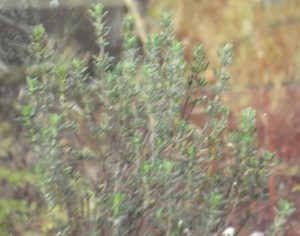 This is a rather romantic picture I took several years ago of thyme in flower. Bees love it, and the whole bush is alive with their neat brown buzzing in the summer.
This is a rather romantic picture I took several years ago of thyme in flower. Bees love it, and the whole bush is alive with their neat brown buzzing in the summer.
Actually the thyme in my garden is much more battered, weather worn and badly pruned than this, and the best specimen I have is in the greenhouse, where it will stay for some months yet.Thyme is a plant I wouldn’t be without. It doesn’t suffer too much from being dried, but the intensity of its rich savoury smell is much diminished, and as it stands the winter pretty well, the only reason for using the dried herb is to avoid a cold soggy trip to the garden- usually after dark – to pick the real thing.
 This was the first herb I ever used in cooking, in my domestic science class at school, where as a touch of the exotic we were allowed to add a pinch to our savoury mince. I still do this, though mince and tatties doesn’t figure quite so much on our menu these days! There are many other varieties of thyme, little creeping ones, some with woolly leaves, variegated ones and ones with lemony or orange tastes. Thyme is mostly associated with grass-lands, places where sheep graze plants down to the ground, which makes it a very good herb to add to lamb, I think – I’d sooner have thyme and garlic with it than mint.
This was the first herb I ever used in cooking, in my domestic science class at school, where as a touch of the exotic we were allowed to add a pinch to our savoury mince. I still do this, though mince and tatties doesn’t figure quite so much on our menu these days! There are many other varieties of thyme, little creeping ones, some with woolly leaves, variegated ones and ones with lemony or orange tastes. Thyme is mostly associated with grass-lands, places where sheep graze plants down to the ground, which makes it a very good herb to add to lamb, I think – I’d sooner have thyme and garlic with it than mint.
The biggest significance of thyme at this time of year is for cleaning. The essential oil, thymol, is a brilliant disinfectant, and will, it is said, even deal with the nasties like MRSA and e-coli. It is also very good for coughs – it’s in all those medicated sweets, and, along with menthol and eucalyptus, is included in most chest rubs. I’ll be making a cleaning fluid from my thyme prunings by boiling them in water for half an hour, and using the strained liquid for wiping down my kitchen surfaces.

Leave a Reply